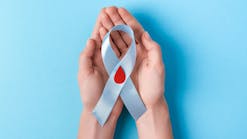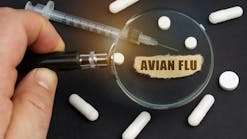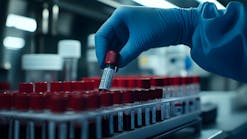MLO recently caught up with two laboratory professionals to see how military laboratories are functioning in Iraq and Afghanistan:
- MAJ Audra L. Taylor, MS, SBB(ASCP), U.S. Army, chief, Laboratory Services, Task Force 28 Combat Support Hospital, and theater laboratory consultant, Baghdad, Iraq, and
- MAJ Matthew T. Swingholm, MS, MT(ASCP)CM, U.S. Army, chief, Blood Bank and Hematology Branch, Department of Clinical Support Services, Army Medical Department (AMEDD) Center and School, Fort Sam Houston, TX, who reports on Afghanistan.
MLO: Let us begin by first finding out what is being done where. Are most lab activities restricted to actual hospitals or mobile hospitals? Are there any pathologists on site?
MAJ Taylor: All laboratory activities are restricted to some type of medical treatment facility (MTF) throughout the theater of operations. Currently, there are no pathologists in Iraq. If, however, pathologists were assigned, they would be located in an MTF. Laboratory support in a theater is established in parallel with our civilian counterparts. The level of available laboratory support will always depend on the size of the MTF. While very small and remote locations offer minimal laboratory services, the larger hospitals — such as TF28 Combat Support Hospital — are able to offer more comprehensive testing in the areas of chemistry, hematology, urinalysis, coagulation, microbiology, and blood banking.
MAJ Swingholm: Medical laboratory technologists (MLTs) can be assigned to one of three types of units in a theater: combat support hospital (CSH), area support medical company (ASMC), or a blood support detachment (BSD). MLTs function in a clinical laboratory capacity when assigned to a CSH or ASMC. When they are assigned to a BSD, their primary focus is shipping, receiving blood products, emergency whole-blood collection, and platelet-aphaeresis collection. Some MLTs conduct site-assist visits which require traveling, usually by aircraft, from one site to another. During these visits, the laboratory is inspected, new standard operating procedures, or SOPs, are issued, and training is conducted on blood management. As of 2009, no pathologists were stationed in the theater. All samples requiring pathology review and diagnosis are shipped to Landstuhl, Germany.
MLO: Are MLTs on the front line, or are they in a hospital/clinic environment? What are the major issues in a war zone that differ from those in civilian hospitals, clinics, and doctors' offices?
MAJ Taylor: While MLTs working in the theater do their absolute best to mirror the conditions in a civilian hospital, clinic, or doctor's office, differences include the supply system, laboratory equipment, and the type of information system used to capture and track patient information.
MAJ Swingholm: The war in Afghanistan is not fought on a linear battlefield. This type of war is more of an asymmetric battlefield, so there is not necessarily a front line. Major issues in the theater include dust problems, information-technology problems, and the normal stresses of long hours with numerous months of separation from family members.
MLO: What would MLTs in a war zone consider the greatest obstacle to obtaining accurate results?
MAJ Taylor: Obstacles often include receipt of reagent/supplies in a timely manner and within the correct temperature range, and shipment of laboratory specimens to another laboratory within the theater. The shipment of laboratory specimens to the designated reference laboratory can present a problem for more isolated locations. It can be challenging to move specimens that may need to be shipped to the United States for some type of specialty testing within the designated time frame. Obtaining accurate results with the testing provided in-house is not problematic. Daily, weekly, and monthly quality control is performed as required, and all equipment is monitored by biomedical maintenance that, in turn, performs the required maintenance. If an equipment or a supply issue appeared to impact the quality of testing performed, then results would not be reported until the problem was solved.
MAJ Swingholm: The greatest obstacle in obtaining accurate laboratory results is dealing with constant dust. Dust gets inside computers, analyzers, and printers. MLTs quickly find themselves conducting a more hardy maintenance schedule and using many cans of compressed air for combating the dust.
MLO: What are the most common errors encountered? How do you follow up on such errors?
MAJ Taylor: Laboratory technicians understand the limitations associated with working in this environment. Processes and procedures are in place to prevent common mistakes that could potentially occur and jeopardize testing. For example, a theater-laboratory submission manual is available at all MTFs. My location has taken it one step further by preparing a “laboratory binder” for the emergency room, operating room, intensive-care unit, and patient ward, which contains this manual as well as the hospital blood-administration policy. Training was performed in each section by laboratory personnel in an effort to minimize mistakes.
Knowing that you are working behind the scenes in direct
support of soldiers, sailors, airmen, Marines, and coalition forces
is great motivation to ensure that a job gets done.
Laboratory personnel attend a daily morning clinical meeting. In addition to reviewing the patients, it is a golden opportunity to address providers with any laboratory issues and/or updates. Overall, we take a proactive approach to dealing with issues as they arise. We encourage everyone to call prior to specimen collection with questions. Despite our greatest efforts, mistakes are made, and specimens must be rejected at times. If the mistake involves an irretrievable specimen such as a tissue, then we will do our best to work with the requesting physician in order to correct the problem. If the problem brings doubt upon the required positive patient identity, et cetera, then we must reject the specimen.
MAJ Swingholm: Errors in the theater are the same as errors back in the USA. The majority are due to human error. Follow up on errors includes counseling and job aids to make sure errors are not repeated.
MLO: Are MLTs able to get all of the reagents and supplies they need in a war zone? Discuss any challenges.
MAJ Taylor: The receipt of reagents and/or supplies is definitely a challenge; and, without question, the process is much more cumbersome than under normal conditions. The process forces laboratory technicians to monitor all supplies and reagents on hand and place orders in a timely manner. In our laboratory, the technicians developed an electronic inventory system and established minimum levels for each item. As supplies are received, the system is manually updated; and, as items are used, the system is also updated. This “process improvement” effort has positively impacted the laboratory.
While the process is currently running smoothly, it was not always this easy and the medical-supply section frequently worked overtime to get what we needed to prevent a negative impact on patient care. In preparation for the next combat-support hospital scheduled to arrive in the theater, we will ensure that adequate supplies are on the shelf and immediately available to facilitate the seamless transition of care.
MAJ Swingholm: Reagents and supplies are easily ordered and maintained on a regular basis. Challenges include constant monitoring of supply inventories, short shelf-life reagents and training new personnel. The workload in a theater hospital is hard to predict, so having a set quota to order each week is nearly impossible at some sites. On any given day, the hospital can receive numerous patients with very severe injuries requiring many blood products and laboratory testing. These events are called mass-casualty events and can quickly reduce inventory supplies in a few hours.
MLO: What is/are the most difficult aspect(s) of an MLT's job in a war zone? What would improve this job?
MAJ Taylor: One of the most difficult aspects of working in a laboratory in a theater is the location restrictions. Many processes cannot be handled overnight. Compared to U.S. labs, you cannot place an order and have it delivered overnight. You cannot ship a specimen to a reference laboratory overnight. You cannot move specimens between or among laboratories in the theater without a great deal of coordination. You cannot assume that all MLTs will have the same level of experience; everyone must work together to train everyone on the equipment and processes. You cannot predict the next sandstorm which will prevent all movement of personnel and supplies.
MAJ Swingholm: The most difficult aspects of an MLT's job in a war zone are the long hours and his or her separation from family members for extended periods. Various methods can be implemented to relieve the stress of long hours. The MLTs have many morale, welfare, and recreation activities available to them as well as spiritual activities. The MLTs also have access to computers with audio and video capabilities to call home and talk to family members.
MLO: What would a MLT likely tell other servicemen and women in the medical-lab field who are without war-zone experience about running a laboratory operation in Afghanistan?
MAJ Taylor: The patient-care mission in the theater is a rewarding experience. Knowing that you are working behind the scenes in direct support of soldiers, sailors, airmen, Marines, and coalition forces is great motivation to ensure that a job gets done. While we understand that a group of inspectors or investigators will not appear on our doorstep, we make every attempt to operate as if they will.
Theater-laboratory support is vital to the overall patient-care mission. It is the goal of all laboratories to operate under the stringent accreditation guidelines set forth by the College of American Pathologists, American Association of Blood Banks, and the Food and Drug Administration.
MAJ Swingholm: I find that MLTs with combat experience are very proud of their combat service. They believe that this is what they have trained for, and saving lives on the battlefield is why they have trained so hard. It provides them with a great sense of accomplishment and gratification. Many of the MLT instructors at the AMEDD Center and School have combat experience and use their experience when training new students just starting the MLT course.
Karen Lynn is a freelance medical writer.





